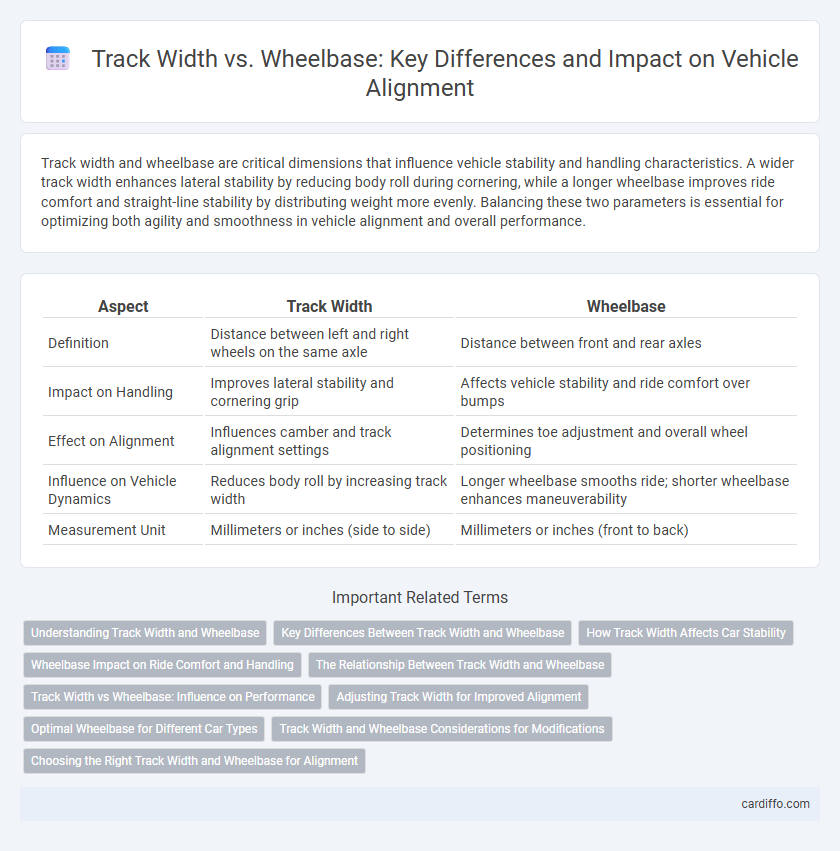Track width and wheelbase are critical dimensions that influence vehicle stability and handling characteristics. A wider track width enhances lateral stability by reducing body roll during cornering, while a longer wheelbase improves ride comfort and straight-line stability by distributing weight more evenly. Balancing these two parameters is essential for optimizing both agility and smoothness in vehicle alignment and overall performance.
Table of Comparison
| Aspect | Track Width | Wheelbase |
|---|---|---|
| Definition | Distance between left and right wheels on the same axle | Distance between front and rear axles |
| Impact on Handling | Improves lateral stability and cornering grip | Affects vehicle stability and ride comfort over bumps |
| Effect on Alignment | Influences camber and track alignment settings | Determines toe adjustment and overall wheel positioning |
| Influence on Vehicle Dynamics | Reduces body roll by increasing track width | Longer wheelbase smooths ride; shorter wheelbase enhances maneuverability |
| Measurement Unit | Millimeters or inches (side to side) | Millimeters or inches (front to back) |
Understanding Track Width and Wheelbase
Track width and wheelbase are critical measurements in vehicle alignment that directly impact stability and handling. Track width refers to the distance between the centers of the left and right wheels on the same axle, influencing cornering grip and lateral stability. Wheelbase, the distance between the front and rear axles, affects ride comfort and overall vehicle balance during acceleration and braking.
Key Differences Between Track Width and Wheelbase
Track width refers to the distance between the centers of two wheels on the same axle, crucial for vehicle stability during cornering. Wheelbase is the length between the centers of the front and rear wheels, impacting ride comfort and handling characteristics. The key difference lies in track width influencing lateral stability and wheelbase affecting longitudinal balance and overall vehicle dynamics.
How Track Width Affects Car Stability
A wider track width increases a vehicle's lateral stability by lowering its center of gravity and reducing body roll during cornering. This enhanced stability helps distribute lateral forces more evenly across the tires, improving grip and reducing the risk of rollover. Track width plays a crucial role in vehicle handling dynamics, often more influential in stability than wheelbase length.
Wheelbase Impact on Ride Comfort and Handling
Wheelbase significantly influences ride comfort and handling by affecting vehicle stability and weight distribution. A longer wheelbase enhances ride comfort by reducing pitch and improving straight-line stability, while a shorter wheelbase allows for more agile handling and quicker directional changes. Proper alignment adjustments considering wheelbase optimize tire contact and suspension performance, leading to balanced handling characteristics and improved overall driving experience.
The Relationship Between Track Width and Wheelbase
The relationship between track width and wheelbase plays a vital role in vehicle stability and handling characteristics, where a wider track width increases lateral stability and reduces body roll during cornering. A longer wheelbase enhances ride comfort and straight-line stability but can reduce maneuverability, making balance between the two dimensions crucial for optimal alignment tuning. Proper alignment settings depend on harmonizing track width and wheelbase to achieve the desired performance and safety outcomes in different driving conditions.
Track Width vs Wheelbase: Influence on Performance
Track width and wheelbase are crucial dimensions that influence vehicle performance by affecting stability, handling, and cornering capabilities. A wider track width improves lateral stability and reduces body roll during turns, while a longer wheelbase enhances straight-line stability and ride comfort. Balancing track width and wheelbase is essential for optimizing vehicle dynamics, with wider track widths favoring agility and longer wheelbases promoting smoother handling at high speeds.
Adjusting Track Width for Improved Alignment
Adjusting track width directly influences vehicle stability and tire wear by modifying the lateral spacing between wheels, which enhances alignment precision. Increasing track width can reduce body roll and improve cornering grip, contributing to better handling characteristics. Precise control of track width allows for optimal suspension geometry alignment, resulting in improved tire contact patches and extended tire life.
Optimal Wheelbase for Different Car Types
Optimal wheelbase varies significantly across car types, influencing ride comfort, handling, and overall vehicle stability during alignment. Sports cars typically benefit from shorter wheelbases around 90-100 inches to enhance agility and cornering precision, while SUVs and trucks favor longer wheelbases exceeding 110 inches for improved straight-line stability and load-bearing capacity. Compact cars fall in the mid-range of 95-105 inches, balancing maneuverability with comfort, making wheelbase a critical parameter in vehicle alignment and dynamics tuning.
Track Width and Wheelbase Considerations for Modifications
Optimizing vehicle performance requires careful consideration of both track width and wheelbase when making modifications. Increasing track width enhances lateral stability and cornering grip by widening the stance, while wheelbase adjustments influence ride quality and directional stability. Balancing these dimensions ensures improved handling dynamics without compromising suspension geometry or drivetrain alignment.
Choosing the Right Track Width and Wheelbase for Alignment
Choosing the right track width and wheelbase is crucial for optimal vehicle alignment, as track width affects lateral stability while wheelbase influences directional control. A wider track width enhances cornering grip by distributing weight more evenly, whereas the wheelbase determines the turning radius and overall ride comfort. Precise alignment settings must account for these dimensions to ensure balanced tire wear and improved handling performance.
Track Width vs Wheelbase Infographic

 cardiffo.com
cardiffo.com